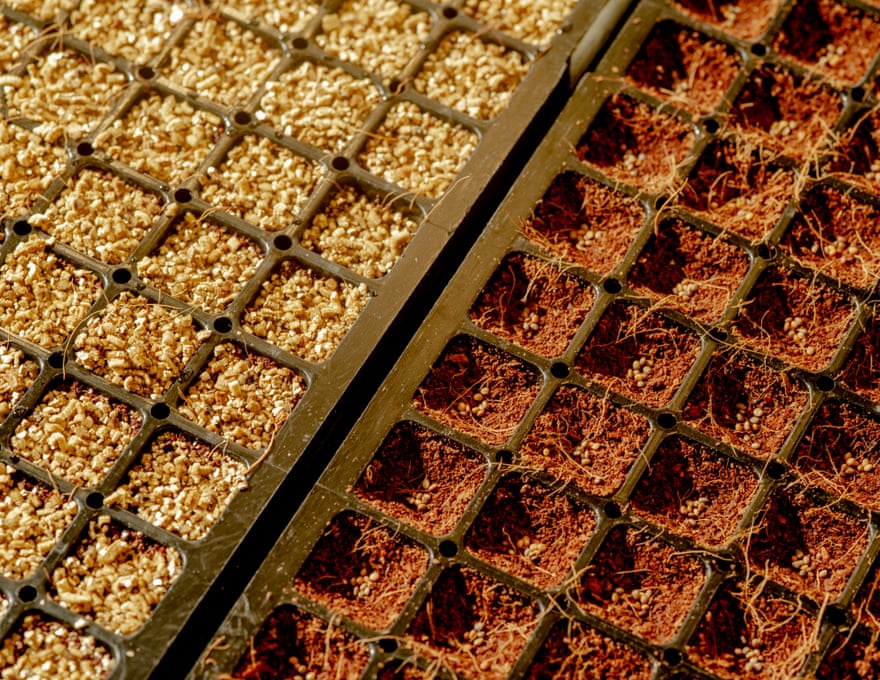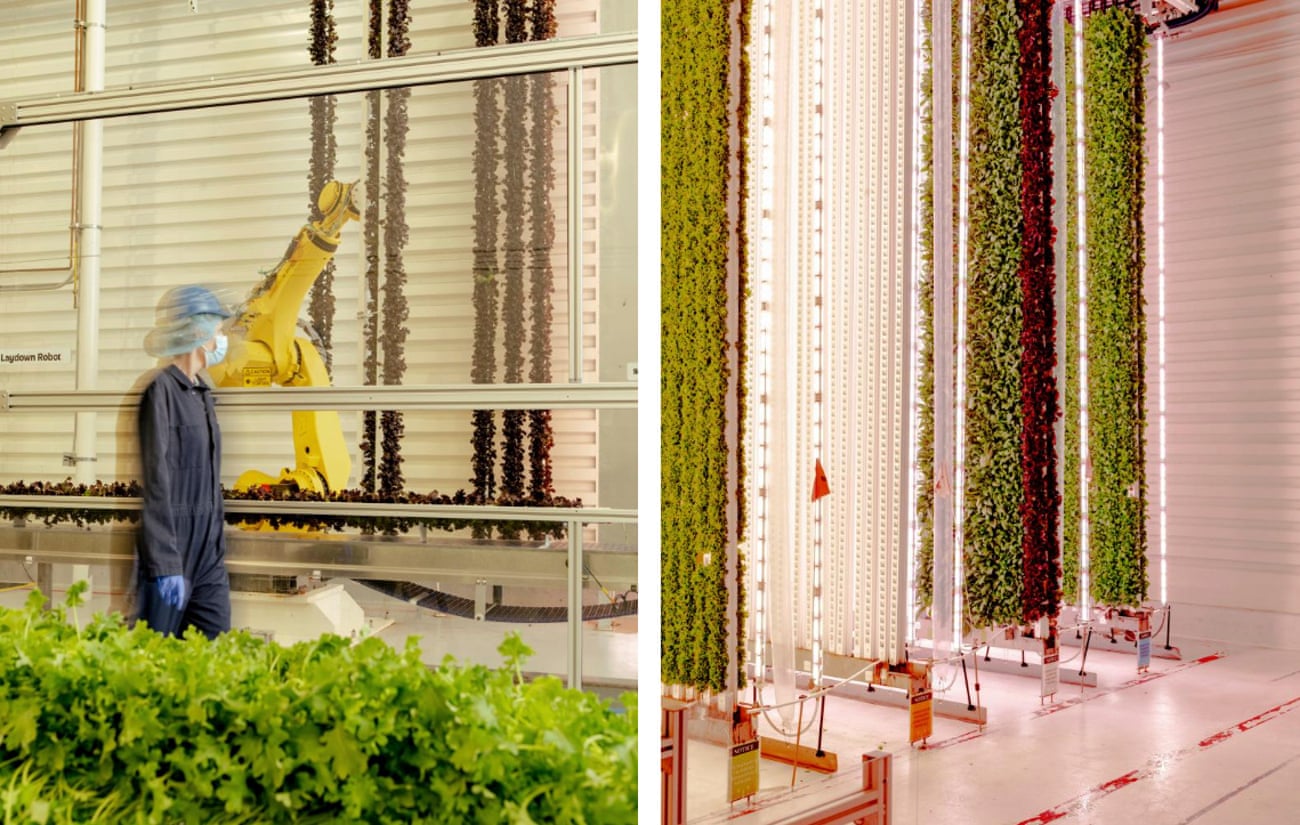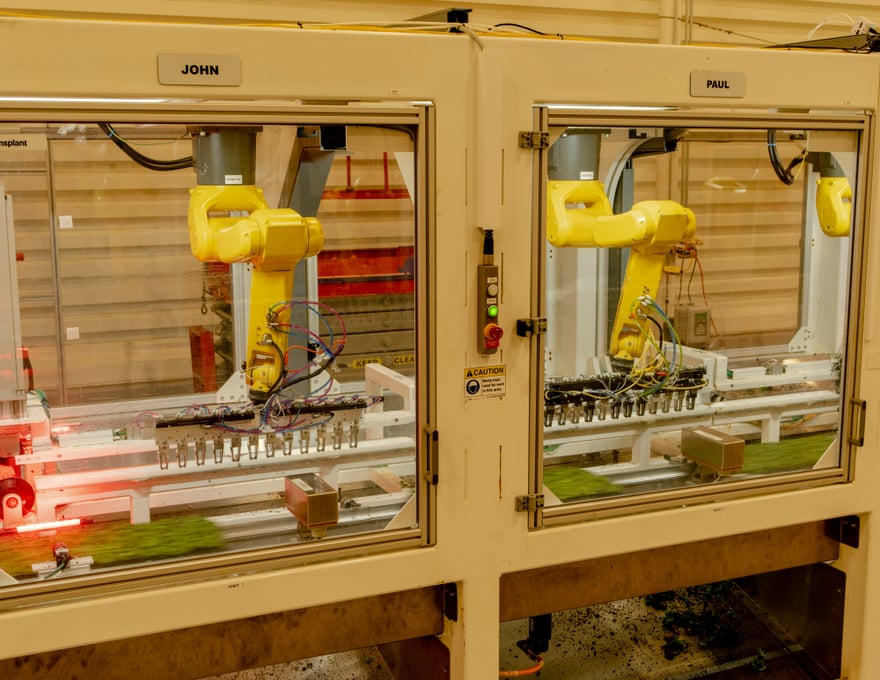Heralded as the following step in meals manufacturing, this apply is gaining floor within the US. However are they actually a greener different to conventional farming?
At a hyper-controlled indoor farm in industrial South San Francisco, 4 robots named John, Paul, George and Ringo rigorously switch seedlings from barcoded trays into 15-plus foot towers which can be then hung vertically inside a 4,800 sq ft develop room.
Contained in the hygienic house, which is operated by the indoor farming firm Loads, there’s no soil, daylight or tractors, however rows of hanging crops illuminated by colourful LED lights and thoroughly monitored by cameras, sensors and synthetic intelligence. As soon as a tower is able to be harvested, a balletic automated course of paying homage to a dry cleaner’s conveyor belt begins.
A robotic named Garfunkel (a close-by counterpart is known as Simon) gently grabs and turns the tower on its aspect earlier than setting it all the way down to be trimmed by a machine. Staff in navy branded jumpsuits examine the greens for any defects, however there are nearly none. Then the pesticide-free product is packaged and placed on a truck to be delivered to a neighborhood market the place the client turns into the primary particular person to the touch it.
Welcome to the world of indoor vertical farming, which, relying on who you ask, will revolutionize the way forward for agriculture in a warming world, or is a problematic local weather answer attributable to its excessive vitality prices.
“We’re transferring into an age the place local weather change is altering what we develop and the way we develop it,” stated Nate Storey, Loads’s co-founder and chief science officer. “In the end, I believe we’re future-proofing agriculture for our species.”
With the world’s inhabitants anticipated to achieve practically 10 billion by 2050, most of whom might be residing in cities, consultants say it would require a 70% enhance from present ranges of worldwide meals manufacturing. However with agricultural land in brief provide because of local weather disaster and urbanization, it’s clear right this moment’s meals methods usually are not prepared.
It’s estimated there are greater than 2,000 vertical farms within the US rising produce comparable to lettuce, herbs and berries. Market leaders comparable to Loads, Bowery, Kalera and AeroFarms – which might function three hundred and sixty five days a 12 months no matter climate situations – and sprawling greenhouses from corporations like AppHarvest and Gotham Greens, see themselves as a part of the answer. And buyers clearly agree.
Indoor farming raised over $1bn in 2021, exceeding the mixed funding generated in 2018 and 2019, and the business is predicted to develop to $9.7bn worldwide by 2026.
Earlier this 12 months, Walmart introduced an funding in Loads as a part of its $400m Sequence E funding spherical. The retail big will supply leafy greens for all of its California shops from Loads’s new 95,000 sq ft flagship farm in Compton, California, which is able to open early subsequent 12 months.
Loads may even be rising Driscoll’s strawberries indoors at their Laramie, Wyoming, analysis and improvement farm as a part of a brand new settlement.
However critics say the large vitality prices wanted to run vertical farms and greenhouses make the apply far much less eco-friendly than their branding suggests and query how they will actually feed a world that depends on energy from grains comparable to soy, corn and wheat.
In the end, I believe we’re future-proofing agriculture for our species
Nate Storey
Designed to provide yields tons of of occasions bigger than conventional out of doors farming, vertical farms occupy areas comparable to buildings or delivery containers whereas utilizing 70 to 95% much less water since they will recapture and recycle water fairly than waste it attributable to poor irrigation or evaporation. Merchandise are totally traceable from seed to shelf, keep brisker longer and there’s little danger of micro organism like E coli, which led to giant recollects of romaine lettuce in 2019 and 2020, since there’s no contamination from runoff water, contaminated animal feces or having to journey lengthy distances in vehicles and cargo planes.
Massive-scale vertical farms are sometimes constructed close to cities the place greens may be bred for taste fairly than storage. With futuristic farming there’s no want for lettuce to sit down inside a truck for days shedding its high quality and dietary worth.
California’s ongoing drought, the demand for regionally grown meals and the latest failures of the provision chain throughout the pandemic has made the apply, which is already fashionable in components of Asia, Europe and the Center East, particularly enticing.

“What’s clear to me is that we’re residing in an more and more unreliable and unsure world,” stated Irving Fain, CEO and founding father of Manhattan-based Bowery Farming. “We have to discover certainty and reliability – and we have to act now.”
Bowery’s good farms within the north-east gather billions of real-time knowledge factors by way of sensors and cameras that feed into machine-learning algorithms to supply their produce to greater than 1,100 grocery shops, together with Entire Meals, Albertsons, Safeway and Amazon.
Within the means of looking for options to vulnerabilities within the meals system, entrepreneurs like Fain say they’re gathering the type of data about plant progress and agronomy that may take a conventional farmer outdoor tons of of years to build up.
“We’re reimagining farming and reinventing the recent meals provide chain and rebuilding one which’s so much less complicated, safer, has far more surety of provide and in the end it’s far more sustainable as effectively,” stated Fain.
I wouldn’t go as far as to say the business will change, and even overtake, standard agriculture.
Brandon Beh
However not everyone seems to be as optimistic about indoor farming’s prospects.
Washington Publish columnist and co-host of the Climavores podcast Tamar Haspel calls vertical farming “lettuce for wealthy individuals”. Throughout a latest episode on vertical farms, Haspel and co-host Mike Grunwald highlighted the methods rising upwards indoors can bypass so most of the issues associated to conventional farming, however say that the massive vitality prices required to energy vertical farms make them a “deal-breaker”.
Whereas Loads, Bowery and different vertical farms don’t launch knowledge on how a lot vitality they use, the 2021 International CEA Census Report discovered that greenhouse growers used 15-20 occasions as a lot vitality, on common, and vertical farms used just a little over 100 occasions as a lot vitality as out of doors lettuce growers in Arizona. The identical report famous that smaller amenities had considerably larger vitality use relative to bigger counterparts.
Different consultants aren’t so certain. Gail Taylor, the division chair of plant sciences on the College of California, Davis, stated that whereas vertical farming is vitality intensive in its present kind, so is conventional out of doors farming.
“Generally we overlook all of the consequential results like what number of occasions you drive a tractor over a discipline or what number of vehicles you employ to deliver lettuce from the west coast to the east coast and fly meals all world wide,” Taylor stated.
Agriculture is already chargeable for about 30% of whole international emissions of carbon dioxide, methane and different planet-warming gasses. Researchers say reducing emissions from meals is essential within the combat to gradual local weather disaster.
Greenhouses have helped flip the Netherlands into the world’s second-largest agricultural exporter by worth, sending over $10bn in tomatoes, cucumbers and bell peppers to neighboring international locations comparable to Germany, Belgium and France in 2020.

However some Dutch greenhouses lately needed to go darkish or reduce manufacturing attributable to hovering energy costs. About 8.2% of the nation’s total consumption of gas is attributed to the glass constructions, which require heating and synthetic gentle to complement daylight.
Whereas rising in managed environments has been round for the reason that Seventies, what made indoor vertical farming a actuality lately was the numerous drop in worth of LED lights, which plummeted as a lot as 94% between 2008 and 2015.
The business is relying on the grid persevering with to get greener, which might drive energy pricing down. “New vitality sources will come on-line,” stated Storey, of Loads. “We’re going to see an enormous and speedy evolution within the house that I believe goes to shock individuals.”
Farms like Loads and Bowery are already powered solely by renewables, however Kale Harbick, a analysis agricultural engineer on the USDA who works on the optimization of controlled-environment agriculture, stated it was necessary to grasp the dimensions of the issue.
There are actually advantages for renewables, however I wouldn’t name them a silver bullet
Kale Harbick
He stated in the event you put a vertical farm in a skyscraper just like the World Commerce Heart to develop lettuce and wished to energy it with renewable vitality like photo voltaic, you would need to bulldoze the remainder of the island of Manhattan to make room for panels to generate sufficient energy only for the lights of that constructing.
“There are actually advantages for renewables, however I wouldn’t name them a silver bullet,” he stated.
Trade watchers say indoor farms have made huge strides lately, and that it’s necessary to do not forget that we’re solely initially of the vertical farming journey.
“I imagine that over the following 10 years, we are going to see the business increase as vertical farms undertake extra sustainable enterprise fashions and the prices of vertical farming lower,” stated know-how analyst Brandon Beh, co-author of a latest report by the know-how firm IDTechEx on vertical farming.
“Vertical farms do handle a key shopper demand for recent, natural produce,” Beh stated. “Nonetheless, I wouldn’t go as far as to say the business will change, and even overtake, standard agriculture.”
Whereas some ag-tech entrepreneurs imagine they will develop nearly something indoors, others admit it’s not possible to provide grain crops comparable to wheat or corn attributable to fundamental economics.
“Area crops are all the time going to be one of the best ways to do calorie grains,” Harbick stated.
Researchers are redesigning crops to develop in these new methods, so stone fruits, mushrooms, eggplants, peppers and cacao crops could also be rising indoors within the close to future.
About one-third of tomatoes are presently grown in greenhouses, however Harbick doesn’t see them being the precise match for vertical farms since they require 60% extra electrical energy to develop than lettuce.

He stated a various meals provide system the place some meals are grown within the discipline, some in greenhouses and a few in vertical farms can be extra resilient and sturdy.
Taylor stated individuals want to begin reimagining indoor farms as a part of the round economic system, noting that different types of renewable vitality, like anaerobic digestion – a course of by means of which micro organism break down natural matter like meals waste – can be utilized to assist energy indoor farms.
One other answer can be to construct vertical farms and greenhouses close to decarbonizing industrial hubs which can be making an attempt to cut back their greenhouse fuel emissions, so farms may seize their warmth and carbon dioxide to avoid wasting electrical energy prices.
And whereas some farmers and scientists are essential concerning the inflow of capital into the vertical and greenhouse farming house, saying indoor-grown meals isn’t essentially higher for individuals or the surroundings, Taylor stated it doesn’t should be an both/or proposition.
“[Indoor farms] are by no means going to exchange out of doors agriculture,” she stated, “they’re solely going to reinforce it and make meals provide methods higher for the world.”
Supply: The Guardian
